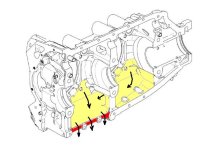I'm firmly in Phase 1 testing having only about 10 hours on my -14A as of today. My cylinder head temperatures came down nicely within only 2-3 hours, and although my oil temps have also come down, that isn't saying much because they were at redline for the first few hours. Now they tend to hover around 220; far hotter than I would like, but at least not redline. Yes, I've checked my baffling and as far as I am able to determine it is perfect. I also don't have any obstructions to the oil cooler. I even tried taping off my heater inlet so as not to be "robbed" of a few square inches of inlet air (it made no difference). The only options I see left are to just keep flying since Lycoming says engine break-in can take 50 hours or more. My other thought is to try retarding the spark advance if the temps aren't down by around my first oil change. My home field is at 6200 feet, so I have been flying at pattern altitude for much of the break-in, around 7500 feet. That usually puts me at around ~23" manifold pressure and 2700 RPM. I'll occasionally dial it back to cruise RPM of 2450, just for some variation. Any other thoughts are welcome.
As for my flaps up stall speed, I'm having trouble nailing it down. When straight and level with the ball centered and the flaps up, it simply won't stall. It will buffet and establish a high sink rate, but it won't stall. I have to be at half or more flaps before it breaks and drops a wing. My empty weight is 1268 and I've tried testing at different all-up weights and with as much as 120 lbs in the baggage area. When the baggage area is empty, by CG is between 83" and 84". With 120 lbs in the baggage area the CG moves back to around 86"+. I can't put enough weight in the baggage area to reach the aft CG, so I'm normally going to be somewhere in the forward 1/3. As far as I can tell, the published flaps up stall speed looks about right. Anyone have a similar experience?
And just a few data points and some motivation for those still building, the pitot/static system is very accurate per my tests and calculations. Additionally, I installed the red cube per the plans and my fuel totalizer is also dead nuts on. No kidding. It wasn't even a tenth of a gallon off after burning 43 out of 50 gallons. I'm also seeing solid true airspeeds of 180-186 knots in level flight at full power settings (~13.3 gal/hr, ~23" and 2700 RPM). Very impressive!
As for my flaps up stall speed, I'm having trouble nailing it down. When straight and level with the ball centered and the flaps up, it simply won't stall. It will buffet and establish a high sink rate, but it won't stall. I have to be at half or more flaps before it breaks and drops a wing. My empty weight is 1268 and I've tried testing at different all-up weights and with as much as 120 lbs in the baggage area. When the baggage area is empty, by CG is between 83" and 84". With 120 lbs in the baggage area the CG moves back to around 86"+. I can't put enough weight in the baggage area to reach the aft CG, so I'm normally going to be somewhere in the forward 1/3. As far as I can tell, the published flaps up stall speed looks about right. Anyone have a similar experience?
And just a few data points and some motivation for those still building, the pitot/static system is very accurate per my tests and calculations. Additionally, I installed the red cube per the plans and my fuel totalizer is also dead nuts on. No kidding. It wasn't even a tenth of a gallon off after burning 43 out of 50 gallons. I'm also seeing solid true airspeeds of 180-186 knots in level flight at full power settings (~13.3 gal/hr, ~23" and 2700 RPM). Very impressive!





